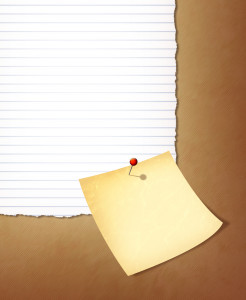You’re writing your book, making occasional references to other books, experts, and information sources. Now you’re wondering whether you need footnotes or endnotes or if it’s okay to leave them out. Good news: most of the time, it is.
But before we get to that, let’s clear up any confusion you might have about the difference between footnotes and endnotes. They’re essentially the same, the only difference being their location. If the note appears at the bottom of a page, it’s called a footnote. If it appears in a list at the back of the book, it’s called an endnote. In the old days, there was no such word as “endnotes.” All notes, whether they appeared at the back of the book or at the bottom of a page, were called “footnotes.” For the sake of simplicity, I will be using the term “footnote” throughout the rest of this article to mean both footnotes and endnotes (being the old-fashioned girl that I am).
 And now on to this article’s main question: does your book have to include these things? Typically, academic, trade, and technical papers employ footnotes, while popular writing does not. That means if you’re writing, say, a self-help or inspirational book, footnotes probably are not necessary. The exception would be if you’re making a lot of references—more than ten or fifteen in the manuscript. Then footnotes would be appropriate, even if you write in a popular genre.
And now on to this article’s main question: does your book have to include these things? Typically, academic, trade, and technical papers employ footnotes, while popular writing does not. That means if you’re writing, say, a self-help or inspirational book, footnotes probably are not necessary. The exception would be if you’re making a lot of references—more than ten or fifteen in the manuscript. Then footnotes would be appropriate, even if you write in a popular genre.
Of course, not needing footnotes doesn’t mean you’re exempt from giving credit when you borrow another writer’s words or quote facts from other sources. It just means you don’t have to give credit via a footnote. Instead, simply include a sentence in the body of the text that mentions where the quote or information is taken from.
This can be done very informally. You only need to provide enough information that if your readers want to look up the source, they will be able to.
Here are a couple of examples:
S elf-publishing authors, in the years ahead, will “have to raise the bar on their own offerings, collaborating with editors and designers while taking a more entrepreneurial approach to their work,” says Alex Palmer in his January 24, 2014 article in Publishers Weekly.
elf-publishing authors, in the years ahead, will “have to raise the bar on their own offerings, collaborating with editors and designers while taking a more entrepreneurial approach to their work,” says Alex Palmer in his January 24, 2014 article in Publishers Weekly.
As Shakespeare wrote in Hamlet, “To footnote or not to footnote, that is the question.”
Okay, I made that last one up. But you can see from the two examples how easy it is to credit your sources simply by telling the reader, in the body of the writing, what that source is when you make the reference or quotation.
 Why is it better in most cases for nonfiction authors not to use footnotes? Because typically you’re writing for the general public. People in general don’t like having to squint to read the tiny print at the bottom of the page—or having to flip to the back of the book every few pages for footnotes at the book’s end.
Why is it better in most cases for nonfiction authors not to use footnotes? Because typically you’re writing for the general public. People in general don’t like having to squint to read the tiny print at the bottom of the page—or having to flip to the back of the book every few pages for footnotes at the book’s end.
We are a society of readers who are short on time and attention. Getting your message across as quickly and simply as possible is a writing skill worth cultivating. This usually includes ditching the footnotes.
ADDENDUM: But what if you’re a scholar or technical writer and ditching the footnotes is not an option? Is it better to place footnotes at the bottom of your pages or in a list at the back of your book? I’ve had authors email me that question after reading this article, so let me add the answer to that here.
If your footnotes are simply citations delineating where your information came from, then put them at the back, as they’re a distraction to the reader. (At the top of the list, write “Endnotes.”)
If, on the other hand, they contain helpful side notes or tangents to what you’ve said in the text, ideas that would illuminate what’s written there, then place your footnotes at the bottom of the page. Good luck!
Jessi Rita Hoffman … book editing by an industry professional
